Upgrading the Smartness of Retrofitting Packages towards Energy-Efficient Residential Buildings in Cold Climate Countries: Two Case Studies
Abstract
1. Introduction
1.1. Building Automation Control Systems
1.2. Simulation-Based Optimization
1.3. Research Objectives
2. Materials and Methods
2.1. Reference Buildings
2.1.1. Case Study 1
2.1.2. Case Study 2
2.2. Building Energy Performance Modeling
2.2.1. Model Validation
2.2.2. Reference BACS Strategies
2.2.3. Objective Function and Solution Space
2.2.4. Simulation-Based Optimization
2.3. Discussion-Based Decision-Making
2.3.1. Difference in Life Cycle Cost Analysis
2.3.2. Thermal Comfort Assessment
3. Results and Discussion
3.1. Validation of the Reference “Original” Building Models
3.2. Validation of the Reference “TEK 17” Models with BACS Control Strategies
3.3. Simulation-Based Optimization and Economic Assessment
3.4. Thermal Comfort Assessment
3.5. Limitations and Further Works
4. Conclusions
Author Contributions
Funding
Acknowledgments
Conflicts of Interest
Appendix A. Electrical Loads and Installed Space Heating Power
| Room Function | Equipment | Case Study | Orientation | Area (m2) | Lighting (W) | Heating (W) |
|---|---|---|---|---|---|---|
| Kitchens | Freezer, fridge, oven, microwave, kettle, small cooking, dishwasher | SF | E | 8.5 | 46 | 1000 |
| AP | S | 6.6 | 46 | 800 | ||
| AP | W | − 1 | − | − | ||
| Living rooms | Television, TV receiver, HiFi, clock, personal computer | SF | W | 37.4 | − 2 | 3800 |
| SF | E&W | 40.3 | − 2 | 3500 | ||
| AP | E | 22.6 | − 2 | 800 | ||
| AP | W | 33.0 | − 2 | 1200 | ||
| Bedrooms | Clock, cordless phone | SF | E&W | 20.4 | 2 × 46 | 2000 |
| SF | E | 9.1 | 46 | 1000 | ||
| SF | W | 11.2 | 46 | 1000 | ||
| AP | E | 11.2 | 46 | 1200 | ||
| AP | E | 35.1 | 3 × 46 | 3000 | ||
| Bathrooms | − | SF | E | 3.5 | 46 | 500 |
| SF | E | 1.6 | 30 | 250 | ||
| SF | − | 1.9 | 30 | 250 | ||
| AP | − | 6.5 | 46 | 500 | ||
| AP | − | 9.8 | 46 | 500 | ||
| Laundry | Iron, vacuum cleaner, washing machine, dryer | SF | E | 6.4 | 46 | − |
| AP | − 3 | − 3 | − 3 | − | ||
| AP | − 3 | − 3 | − 3 | − | ||
| Halls | − | SF | E | 7.4 | 46 | 500 |
| SF | W | 4.8 | 30 | 250 | ||
| AP | − | 6.5 | 30 | 500 | ||
| AP | − | 7.4 | 30 | 500 | ||
| Stairs | − | SF | − | 2.5 | 30 | − |
| Storage | − | SF | E | 19.2 | 30 | − |
Appendix B. Variable Temperature Setpoints
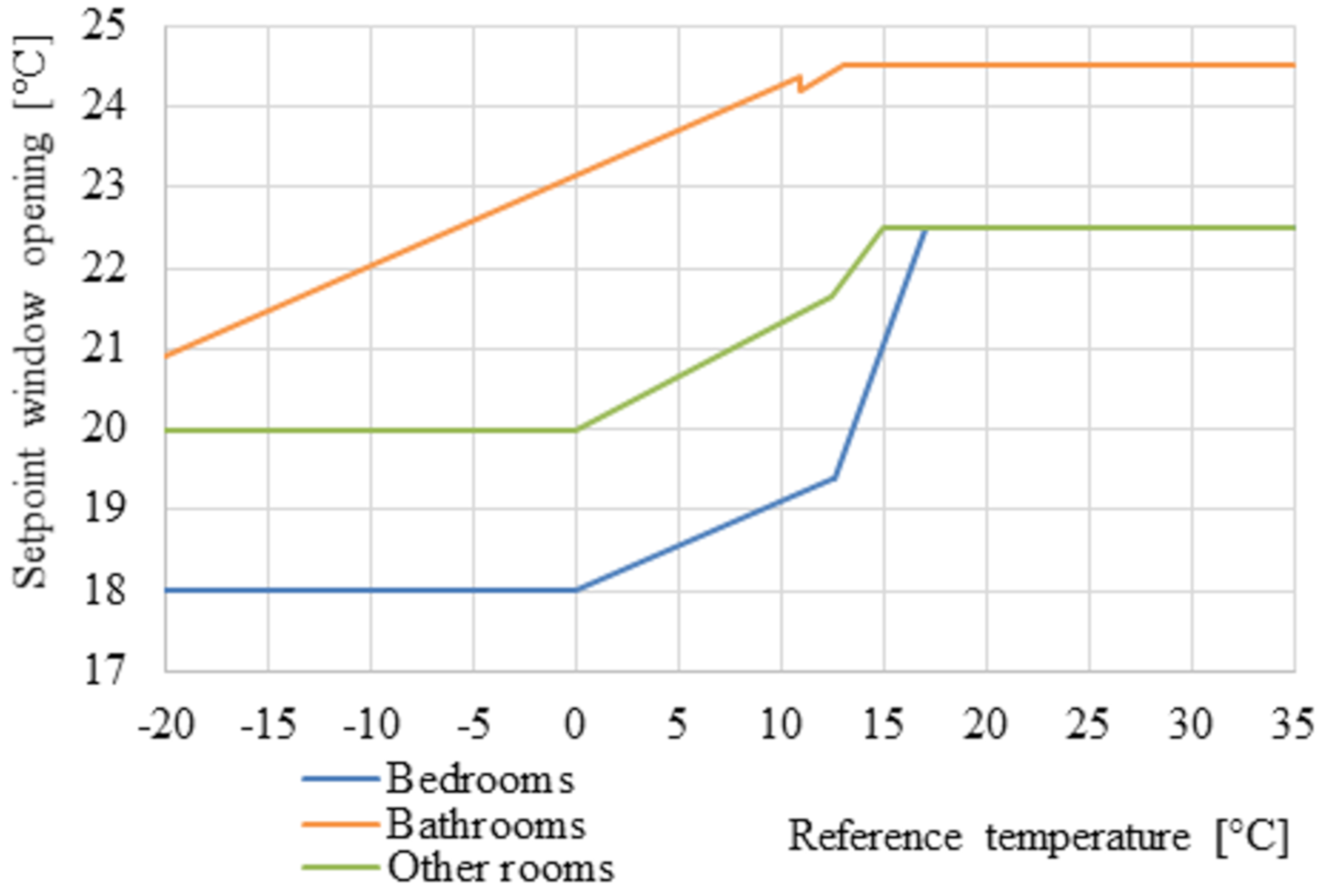
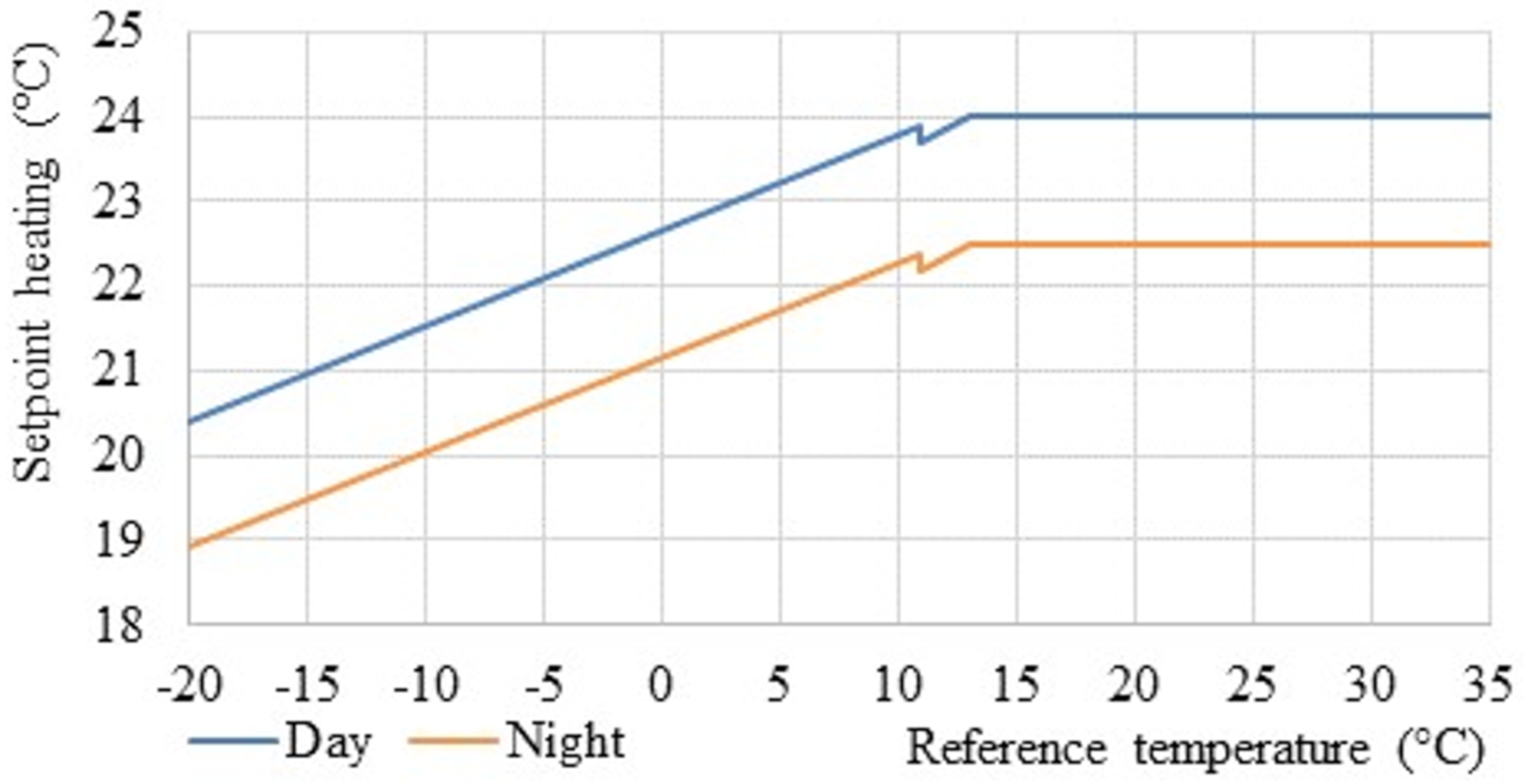
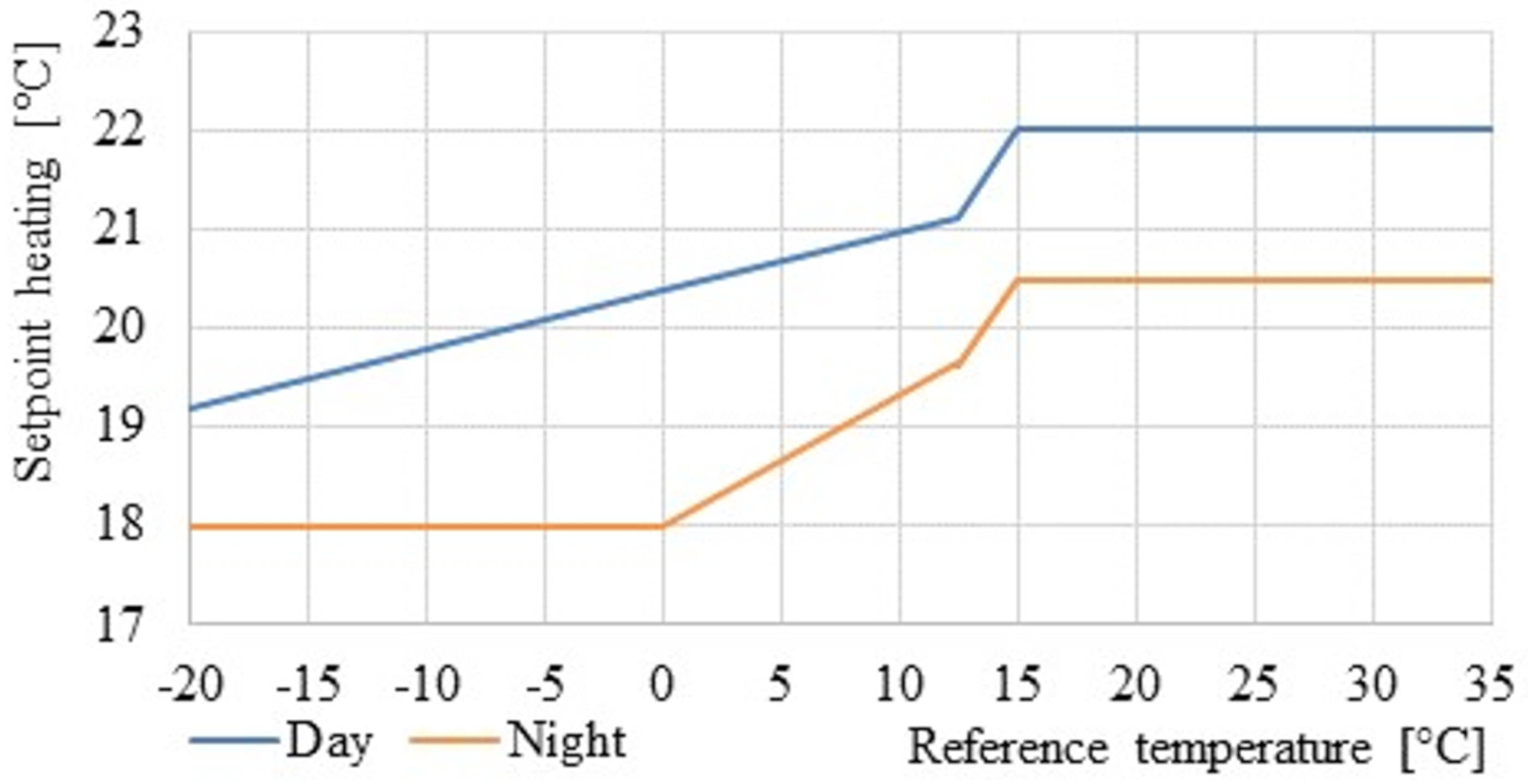
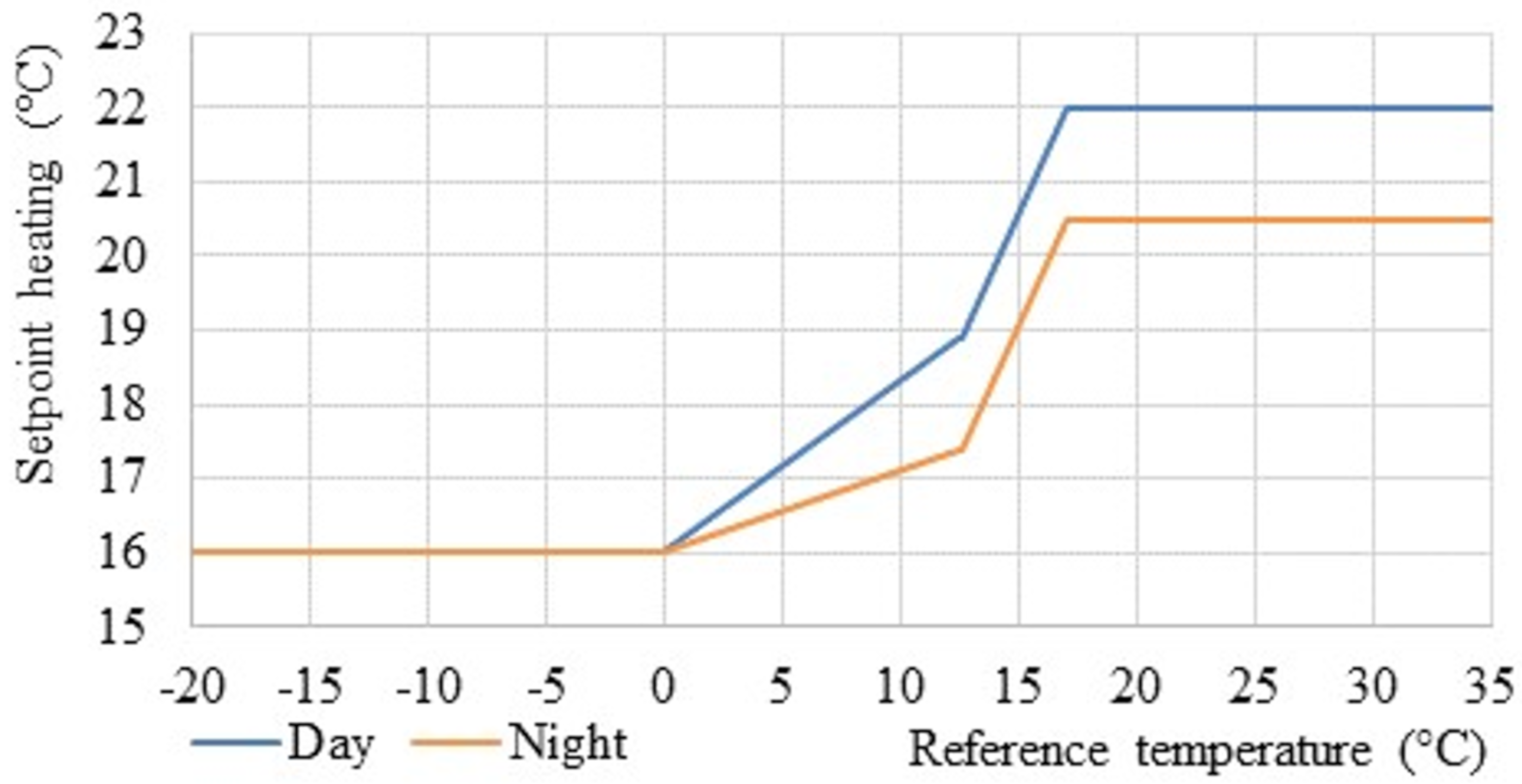
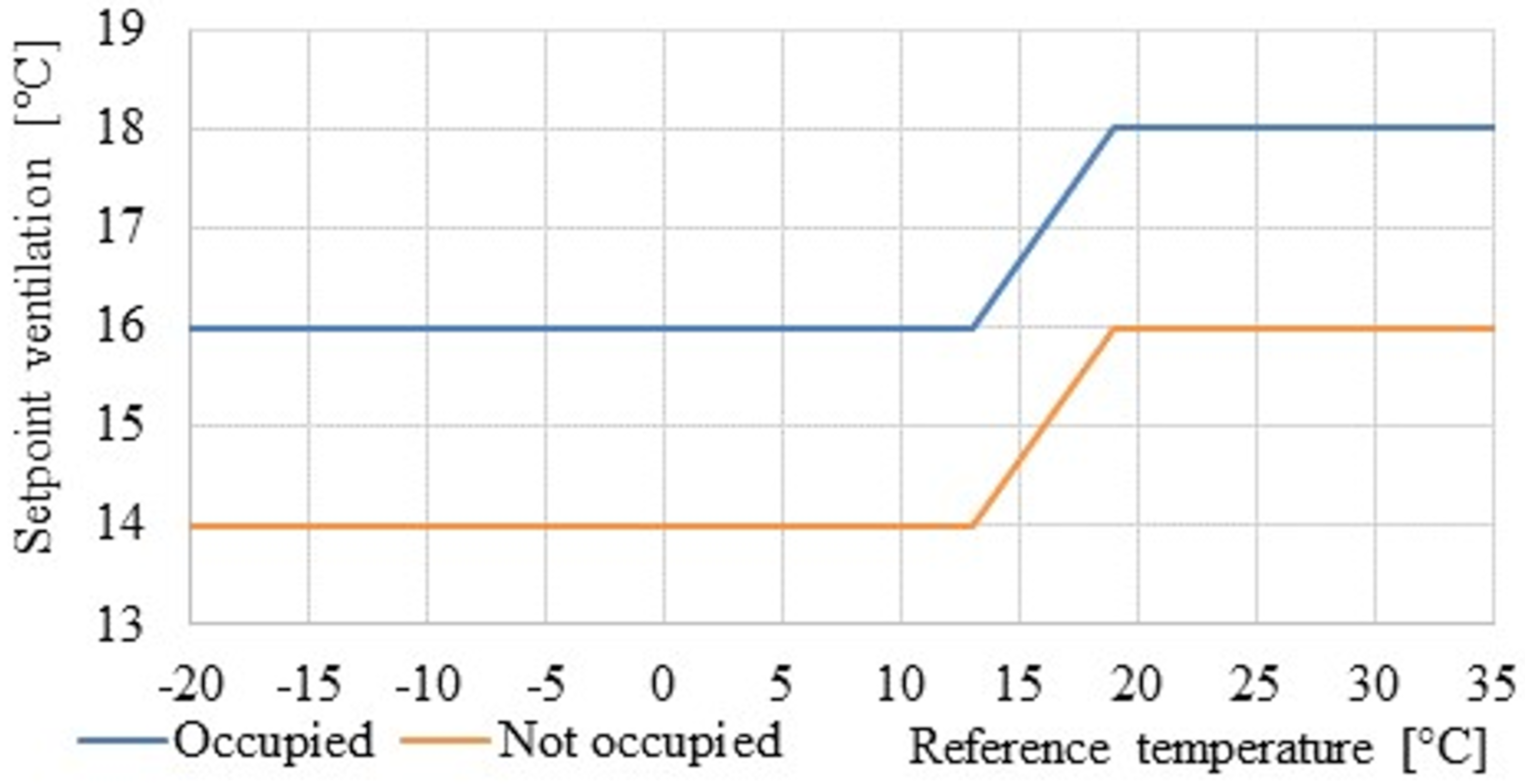
Appendix C. Investment Cost
| Retrofitting Measure | Options | Cost (€/m2) |
|---|---|---|
| Additional external wall insulation (original 10 cm) Including: removing the original cladding, adding a wind barrier, adding mineral wool insulation (variable thickness) and timber frame, adding cladding | 10 + 10 cm | 118.2 |
| 10 + 15 cm | 129.0 | |
| 10 + 20 cm | 157.6 | |
| 10 + 25 cm | 172.7 | |
| 10 + 30 cm | 180.4 | |
| Additional insulation sloped roof, single-family house (original 10 cm) Including: demolition of the roof cladding, removing insulation from the loft, adding mineral wool insulation (variable thickness) and timber frame to the sloped roof, adding wind and vapor barriers, adding cladding | 0 + 20 cm | 193.9 |
| 0 + 25 cm | 203.7 | |
| 0 + 30 cm | 211.8 | |
| 0 + 35 cm | 218.8 | |
| 0 + 40 cm | 225.1 | |
| Additional insulation flat roof, apartments (original 10 cm) Including: demolition of the roof cladding and insulation, adding expanded polystyrene (EPS) insulation (variable thickness), adding new cladding | 10 + 10 cm | 68.3 |
| 10 + 15 cm | 76.4 | |
| 10 + 20 cm | 85.4 | |
| 10 + 25 cm | 91.9 | |
| 10 + 30 cm | 98.5 | |
| Additional insulation basement walls (original 0 cm) Including: digging out mass, adding EPS insulation (variable thickness) | 0 + 15 cm | 65.5 |
| 0 + 20 cm | 85.6 | |
| 0 + 25 cm | 96.6 | |
| 0 + 30 cm | 107.7 | |
| Additional insulation basement floor (original 0 cm) Including: demolition of flooring and concrete floor, digging out mass, adding EPS insulation (variable thickness), adding new concrete floor and flooring | 0 + 10 cm | 259.1 |
| 0 + 15 cm | 270.6 | |
| 0 + 20 cm | 275.1 | |
| 0 + 25 cm | 286.6 | |
| 0 + 30 cm | 291.2 | |
| 0 + 35 cm | 302.6 |
| Retrofitting Measure | Options | Cost (€) |
|---|---|---|
| Replacement of all windows, single-family house (original U = 2.8 W/m2) Including: removing old windows, placing new windows | U = 1.2 W/m2 | 19,984 |
| U = 0.8 W/m2 | 22,978 | |
| Replacement of all windows, apartments (original U = 2.8 W/m2) Including: removing old windows, placing new windows | U = 1.2 W/m2 | 8437 |
| U = 0.8 W/m2 | 9983 | |
| Air source heat pump, including installation | − | 2234 |
| Automation Measure | Options | Cost (€) |
|---|---|---|
| Overall automation, single-family house | − | 716 |
| Overall automation, apartments | − | 1027 |
| Heating control, single-family house Including: smart heaters, sensors | Class C | 2450 |
| Class B | 2571 | |
| Class A | 3375 | |
| Heating control, apartments Including: smart heaters, sensors | Class C | 2206 |
| Class B | 2447 | |
| Class A | 3410 | |
| Ventilation control, single-family house Including: balanced ventilation system, sensors | Class D | 8554 |
| Class C | 12,295 | |
| Class B | 12,502 | |
| Class A | 12,678 | |
| Ventilation control, apartments Including: balanced ventilation system, sensors | Class D | 7672 |
| Class C | 7672 | |
| Class B | 8085 | |
| Class A | 8438 | |
| Lighting control, single-family house Including: sensors | Class B | 1926 |
| Class A | 4571 | |
| Lighting control, apartments Including: sensors | Class B | 1284 |
| Class A | 3047 | |
| Blind control, single-family house Including: motorized blinds, sensors | Class B | 2497 |
| Blind control, apartments Including: motorized blinds, sensors | Class B | 2110 |
| Control Strategy | Options | Sensors |
|---|---|---|
| Heating control | Class C | Weather sensor |
| Class B | Weather sensor, occupancy sensor | |
| Class A | Weather sensor, motion sensor in every room | |
| Ventilation control | Class C | - |
| Class B | Weather sensor, temperature sensor | |
| Class A | Weather sensor, temperature sensor, motion sensor in every room | |
| Lighting control | Class B | Daylight sensor in every room |
| Class A | Daylight sensor in every room, motion sensor in every room | |
| Blind control | Class B | Solar radiation sensor on every facade |
References
- Felius, L.C.; Dessen, F.; Hrynyszyn, B.D. Retrofitting towards energy-efficient homes in European cold climates: A review. Energy Effic. 2019, 13, 1–25. [Google Scholar]
- European Parliament, Council of the European Union. Directive (EU) 2018/844 of the European Parliament and of the Council of 30 May 2018 amending Directive 2010/31/EU on the energy performance of buildings and Directive 2012/27/EU on energy efficiency (Text with EEA relevance). Off. J. Eur. Union 2018, 156, 75–91. [Google Scholar]
- Ippolito, M.; Sanseverino, E.R.; Zizzo, G. Impact of building automation control systems and technical building management systems on the energy performance class of residential buildings: An Italian case study. Energy Build. 2014, 69, 33–40. [Google Scholar] [CrossRef]
- Sanseverino, E.R.; Zizzo, G.; La Cascia, D. Economic impact of BACS and TBM systems on residential buildings. In Proceedings of the 2013 International Conference on Clean Electrical Power (ICCEP), Alghero, Italy, 11–13 June 2013; pp. 591–595. [Google Scholar]
- Vallati, A.; Grignaffini, S.; Romagna, M.; Mauri, L. Effects of different building automation systems on the energy consumption for three thermal insulation values of the building envelope. In Proceedings of the 2016 IEEE 16th International Conference on Environment and Electrical Engineering (EEEIC), Florence, Italy, 7–10 June 2016; pp. 1–5. [Google Scholar]
- López-González, L.M.; López-Ochoa, L.M.; Las-Heras-Casas, J.; García-Lozano, C. Update of energy performance certificates in the residential sector and scenarios that consider the impact of automation, control and management systems: A case study of La Rioja. Appl. Energy 2016, 178, 308–322. [Google Scholar] [CrossRef]
- Reda, F.; Pasini, D.; Laitinen, A.; Vesanen, T. ICT intelligent support solutions toward the reduction of heating demand in cold and mild European climate conditions. Energy Effic. 2019, 12, 1443–1471. [Google Scholar] [CrossRef]
- Felius, L.C.; Lamb, J.J.; Hrynyszyn, B.D.; Dessen, F. Smart components and systems. In Energy-Smart Buildings; IOP Publishing: Bristol, UK, 2020; pp. 4-1–4-16. [Google Scholar]
- Hasan, A.; Vuolle, M.; Sirén, K. Minimisation of life cycle cost of a detached house using combined simulation and optimisation. Build. Environ. 2008, 43, 2022–2034. [Google Scholar] [CrossRef]
- Hirvonen, J.; Jokisalo, J.; Heljo, J.; Kosonen, R. Towards the EU emissions targets of 2050: Optimal energy renovation measures of Finnish apartment buildings. Int. J. Sustain. Energy 2019, 38, 649–672. [Google Scholar] [CrossRef]
- Niemelä, T.; Kosonen, R.; Jokisalo, J. Cost-effectiveness of energy performance renovation measures in Finnish brick apartment buildings. Energy Build. 2017, 137, 60–75. [Google Scholar] [CrossRef]
- Tokarik, M.S.; Richman, R.C. Life cycle cost optimization of passive energy efficiency improvements in a Toronto house. Energy Build. 2016, 118, 160–169. [Google Scholar] [CrossRef]
- La Fleur, L.; Rohdin, P.; Moshfegh, B. Investigating cost-optimal energy renovation of a multifamily building in Sweden. Energy Build. 2019, 203, 109438. [Google Scholar] [CrossRef]
- Hamdy, M.; Sirén, K. A multi-aid optimization scheme for large-scale investigation of cost-optimality and energy performance of buildings. J. Build. Perform. Simul. 2016, 9, 411–430. [Google Scholar] [CrossRef]
- Hamdy, M.; Mauro, G.M. Multi-objective optimization of building energy design to reconcile collective and private perspectives: CO2-eq vs. Discounted payback time. Energies 2017, 10, 1016. [Google Scholar] [CrossRef]
- Thyholt, M.; Pettersen, T.D.; Haavik, T.; Wachenfeldt, B.J. Energy analysis of the Norwegian dwelling stock. IEA Task 2009, 37, 1–66. [Google Scholar]
- Statistics Norway. Dwellings. Available online: https://www.ssb.no/en/bygg-bolig-og-eiendom/statistikker/boligstat (accessed on 12 March 2020).
- NS 3031 Energy Performance of Buildings: Calculation of Energy Needs and Energy Supply; Standard Norge: Oslo, Norway, 2016.
- Felius, L.; Hamdy, M.; Hrynyszyn, B.; Dessen, F. The impact of building automation control systems as retrofitting measures on the energy efficiency of a typical Norwegian single-family house. In Proceedings of the IOP Conference Series: Earth and Environmental Science, Thessaloniki, Greece, 23–25 October 2019; p. 012054. [Google Scholar]
- Direktoratet for byggkvalitet. Regulations on Technical Requirements for Construction Works (TEK17). 2017. Available online: https://dibk.no/byggereglene/byggteknisk-forskrift-tek17 (accessed on 11 December 2018).
- Direktoratet for byggkvalitet. Regulations on Technical Requirements for Construction Works. 1969. Available online: https://dibk.no/globalassets/byggeregler/tidligere_regelverk/historisk-arkiv-1949---1987/byggeforskrift-1969.pdf (accessed on 26 May 2020).
- EQUA. IDA Indoor Climate and Energy, 4.1. Available online: https://www.equa.se/en/ida-ice (accessed on 5 November 2019).
- Nord, N.; Tereshchenko, T.; Qvistgaard, L.H.; Tryggestad, I.S. Influence of occupant behavior and operation on performance of a residential Zero Emission Building in Norway. Energy Build. 2018, 159, 75–88. [Google Scholar] [CrossRef]
- Richardson, I.; Thomson, M.; Infield, D.; Delahunty, A. Domestic lighting: A high-resolution energy demand model. Energy Build. 2009, 41, 781–789. [Google Scholar] [CrossRef]
- Richardson, I.; Thomson, M.; Infield, D.; Clifford, C. Domestic electricity use: A high-resolution energy demand model. Energy Build. 2010, 42, 1878–1887. [Google Scholar] [CrossRef]
- Andersen, R.; Fabi, V.; Toftum, J.; Corgnati, S.P.; Olesen, B.W. Window opening behaviour modelled from measurements in Danish dwellings. Build. Environ. 2013, 69, 101–113. [Google Scholar] [CrossRef]
- Hagen, H. Byggforsk 552.103 Heating of dwellings. Energy consumption and cost. 1990. Available online: https://www.byggforsk.no/dokument/519/oppvarming_av_boliger_energiforbruk_og_kostnader (accessed on 12 March 2020).
- Energy Performance of Buildings—Part 1: Impact of Building Automation, Controls and Building Management; EN 15232-1:2017; European Committee for Standardization: Brussels, Belgium, 2017.
- Peeters, L.; De Dear, R.; Hensen, J.; D’haeseleer, W. Thermal comfort in residential buildings: Comfort values and scales for building energy simulation. Appl. Energy 2009, 86, 772–780. [Google Scholar] [CrossRef]
- Energy Performance of Buildings—Ventilation for Buildings–Part 1: Indoor Environmental Input Parameters for Design and Assessment of Energy Performance of Buildings Addressing Indoor Air Quality, Thermal Environment, Lighting and Acoustics; EN 16798-1; European Committee for Standardization: Brussels, Belgium, 2019.
- Criteria for Passive Houses and Low Energy Buildings—Residential Buildings; NS 3700; Standard Norge: Oslo, Norway, 2013.
- Lawrence Berkeley National Laboratory. GenOpt, 3.1.1. Available online: https://simulationresearch.lbl.gov/GO/ (accessed on 5 November 2019).
- Hamdy, M.; Hasan, A.; Siren, K. A multi-stage optimization method for cost-optimal and nearly-zero-energy building solutions in line with the EPBD-recast 2010. Energy Build. 2013, 56, 189–203. [Google Scholar] [CrossRef]
- Jensen, A.R.; Olle, R. Norwegian Pricebook 2018; Norconsult Informasjonssystemer AS: Sandvika, Norway; Bygganalyse AS: Oslo, Norway, 2018. [Google Scholar]
- Statistics Norway. Energy Consumption in Households. Available online: https://www.ssb.no/en/energi-og-industri/statistikker/husenergi (accessed on 12 March 2020).
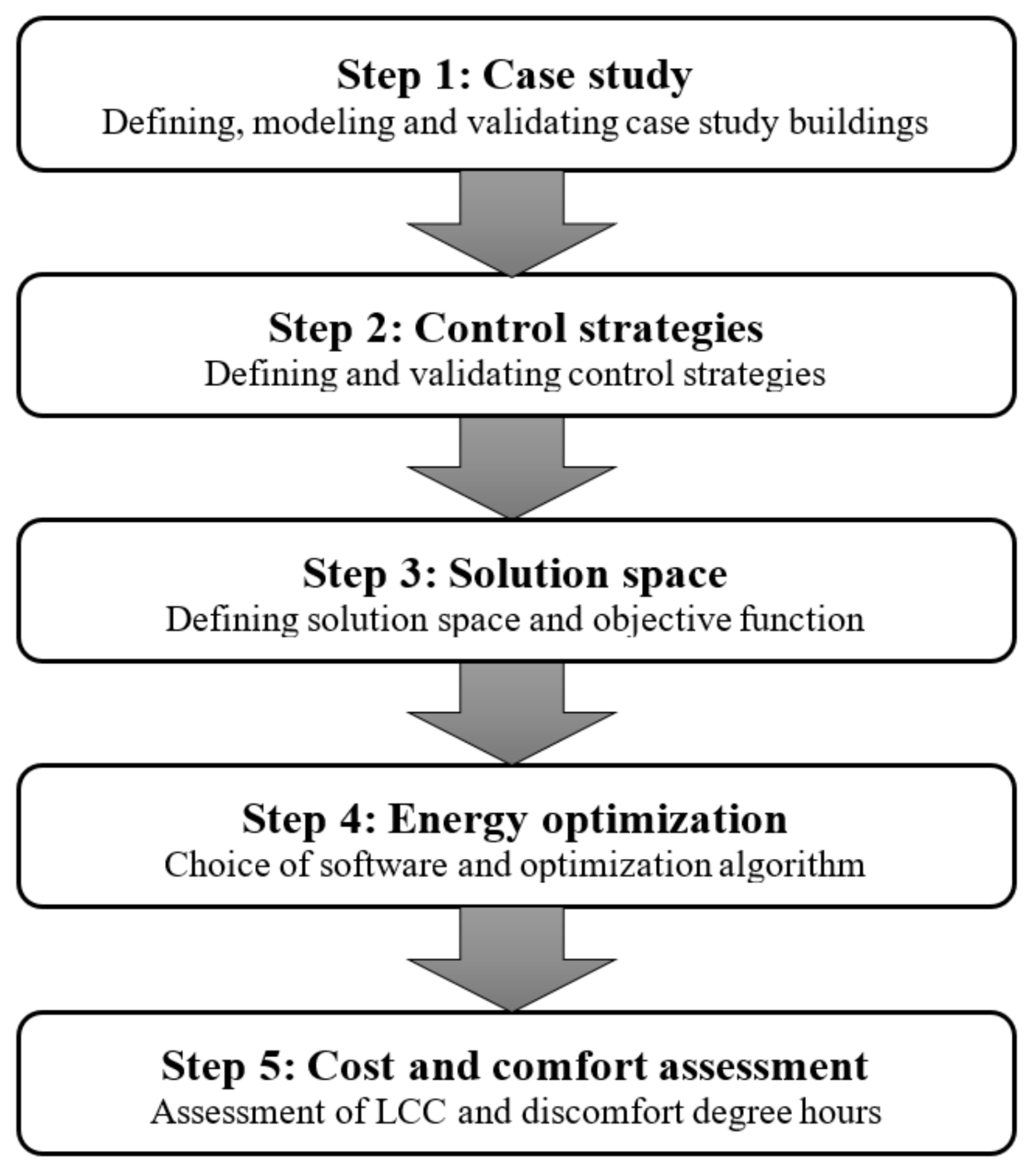

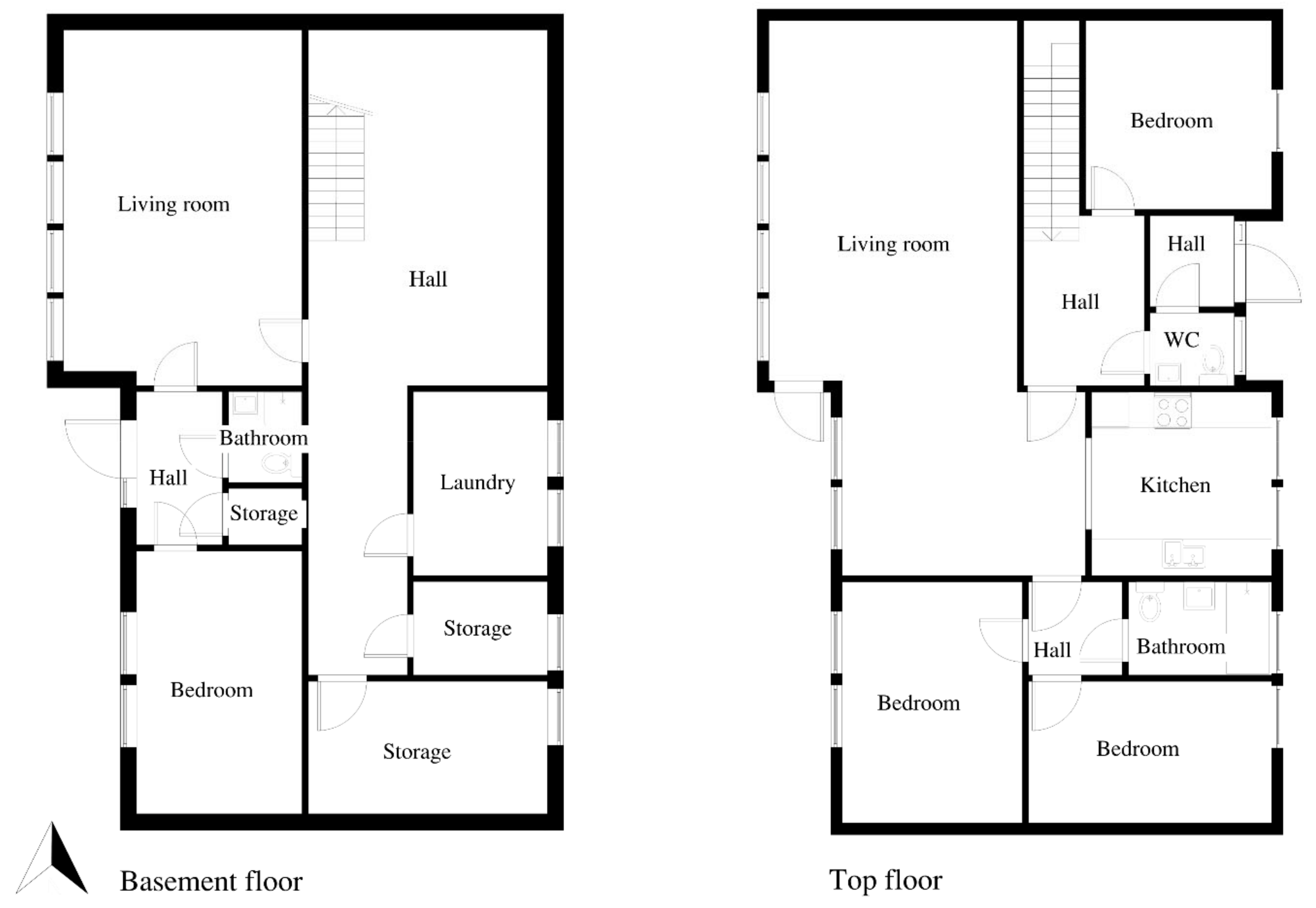
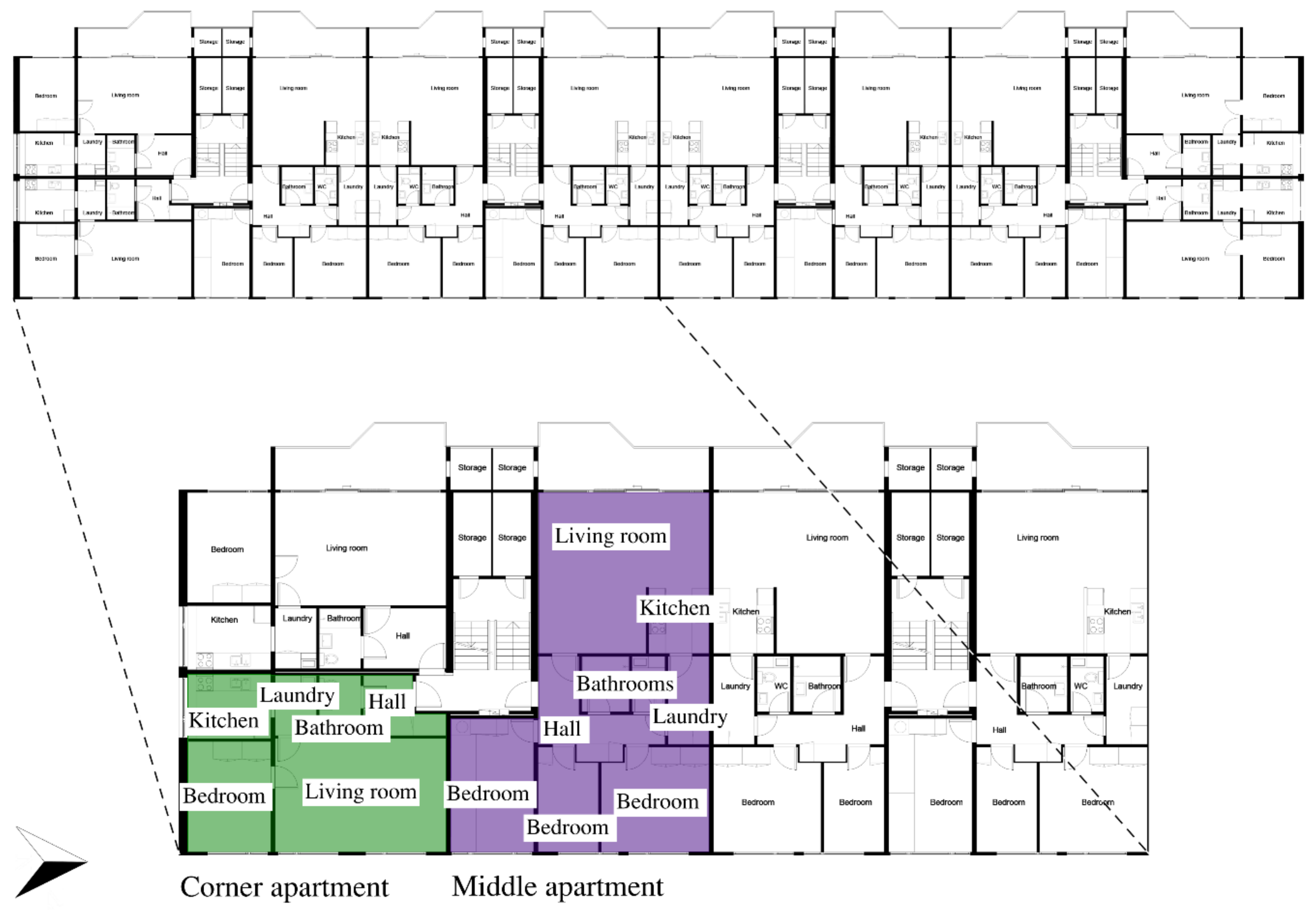
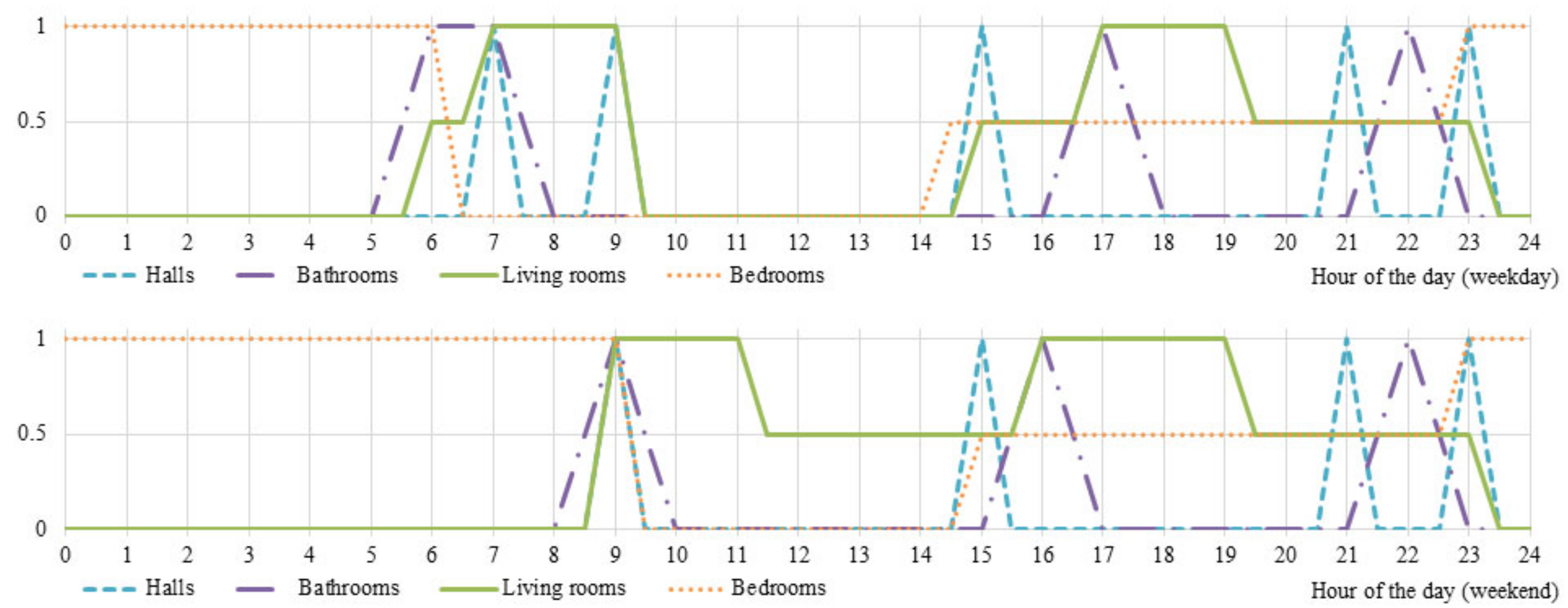
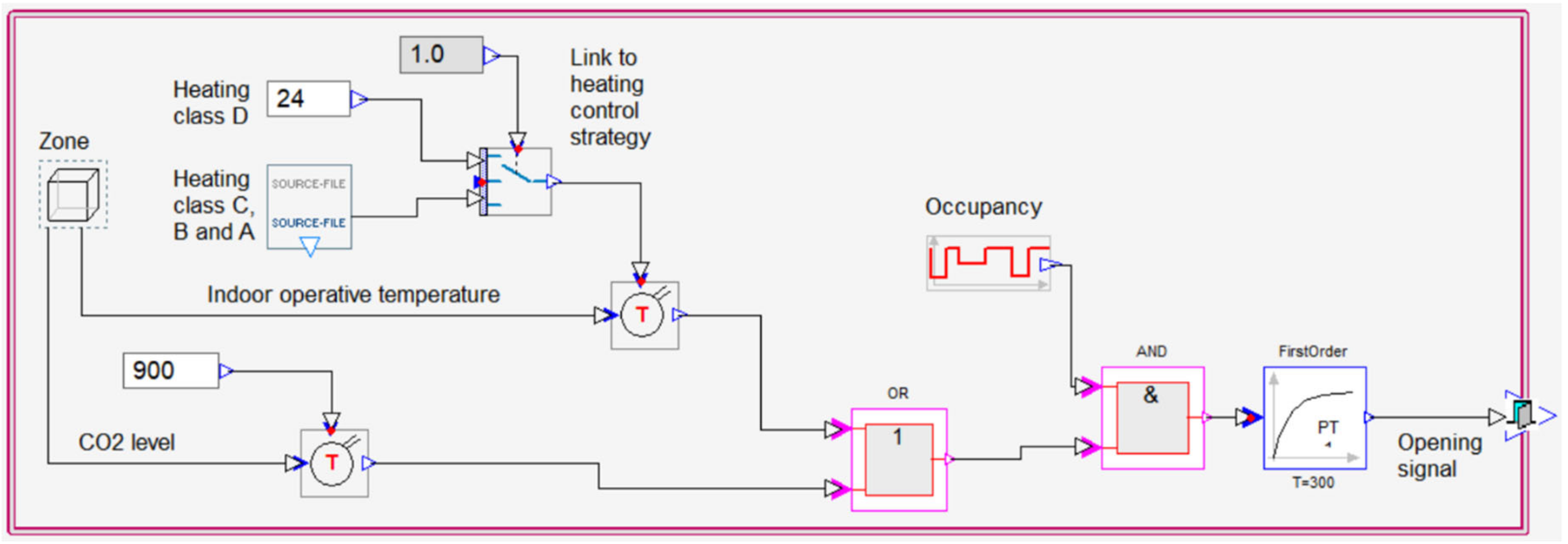

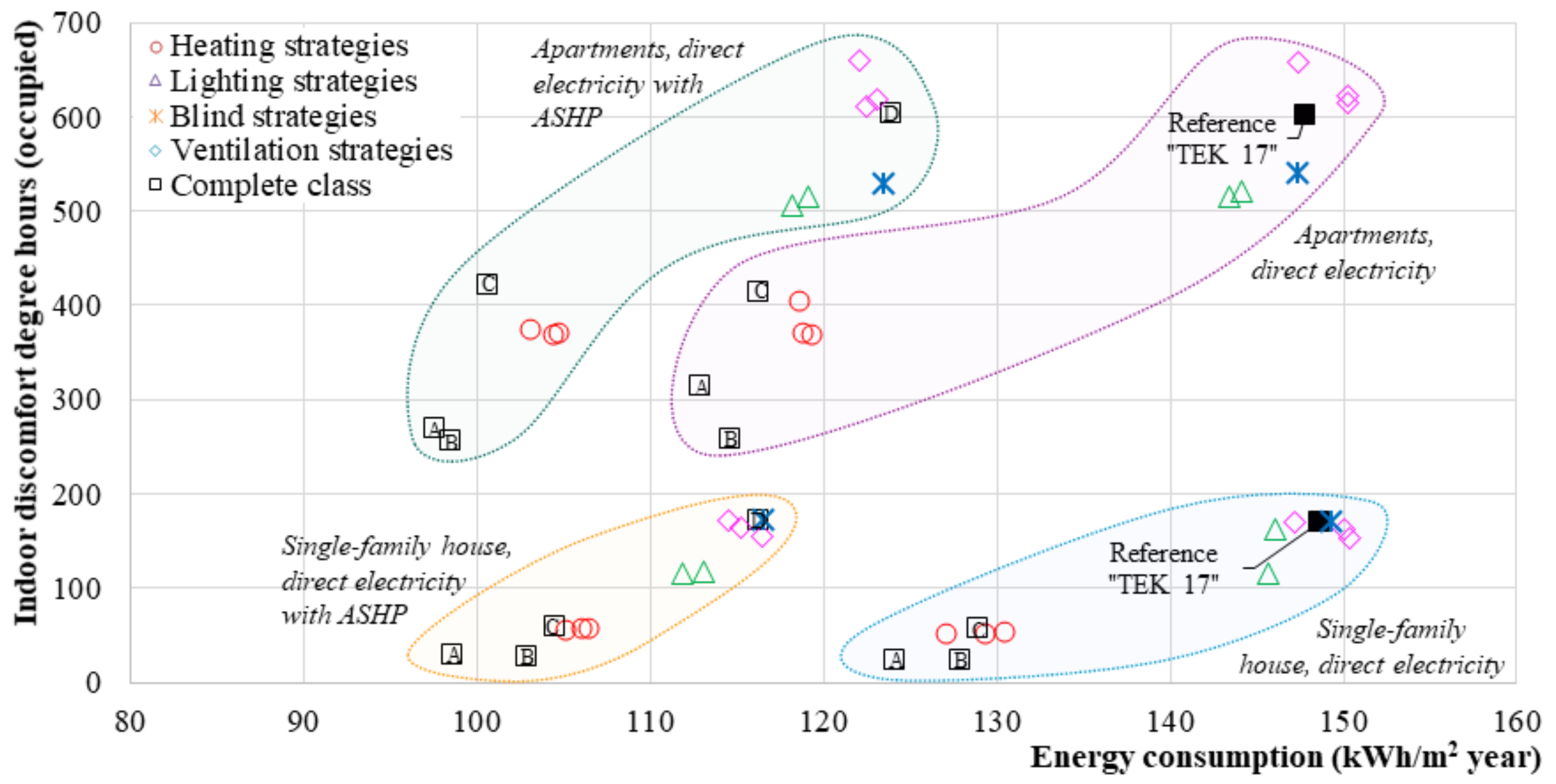
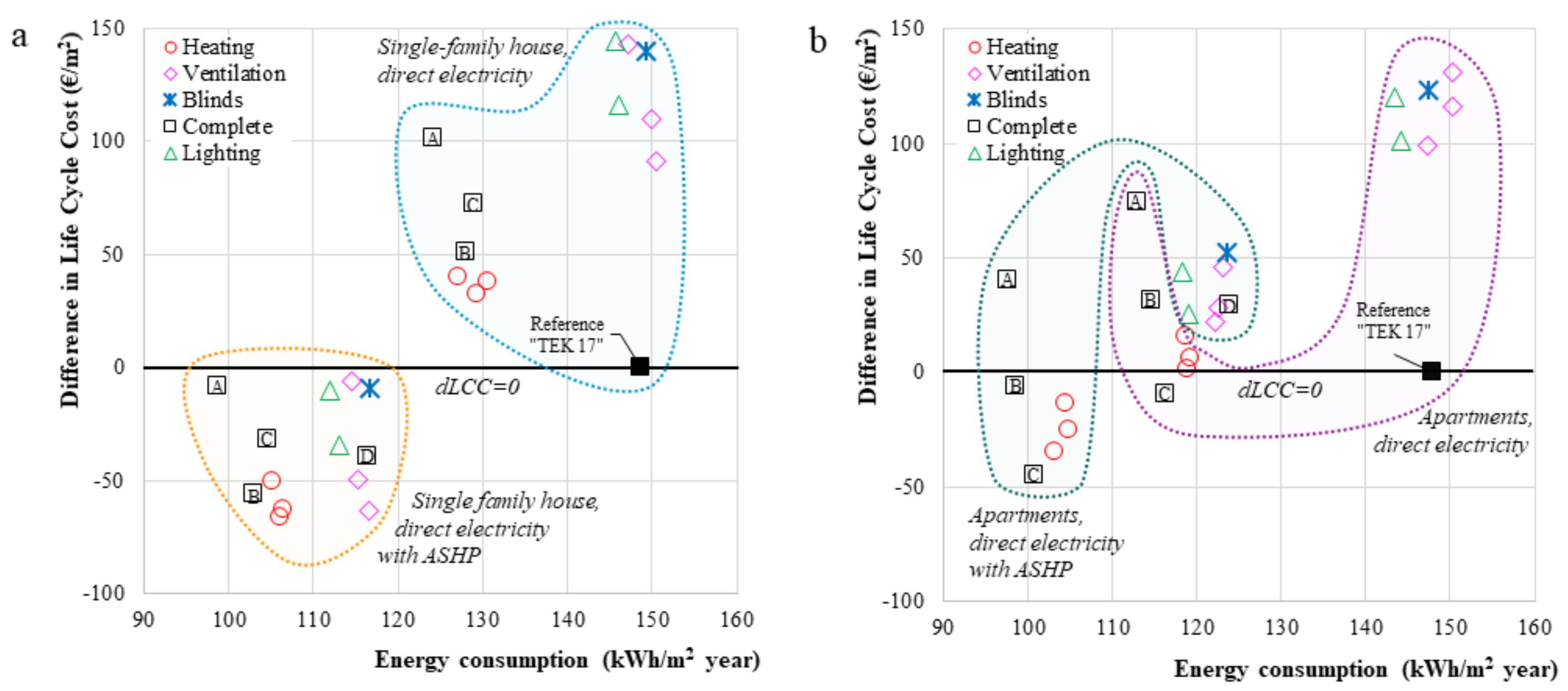
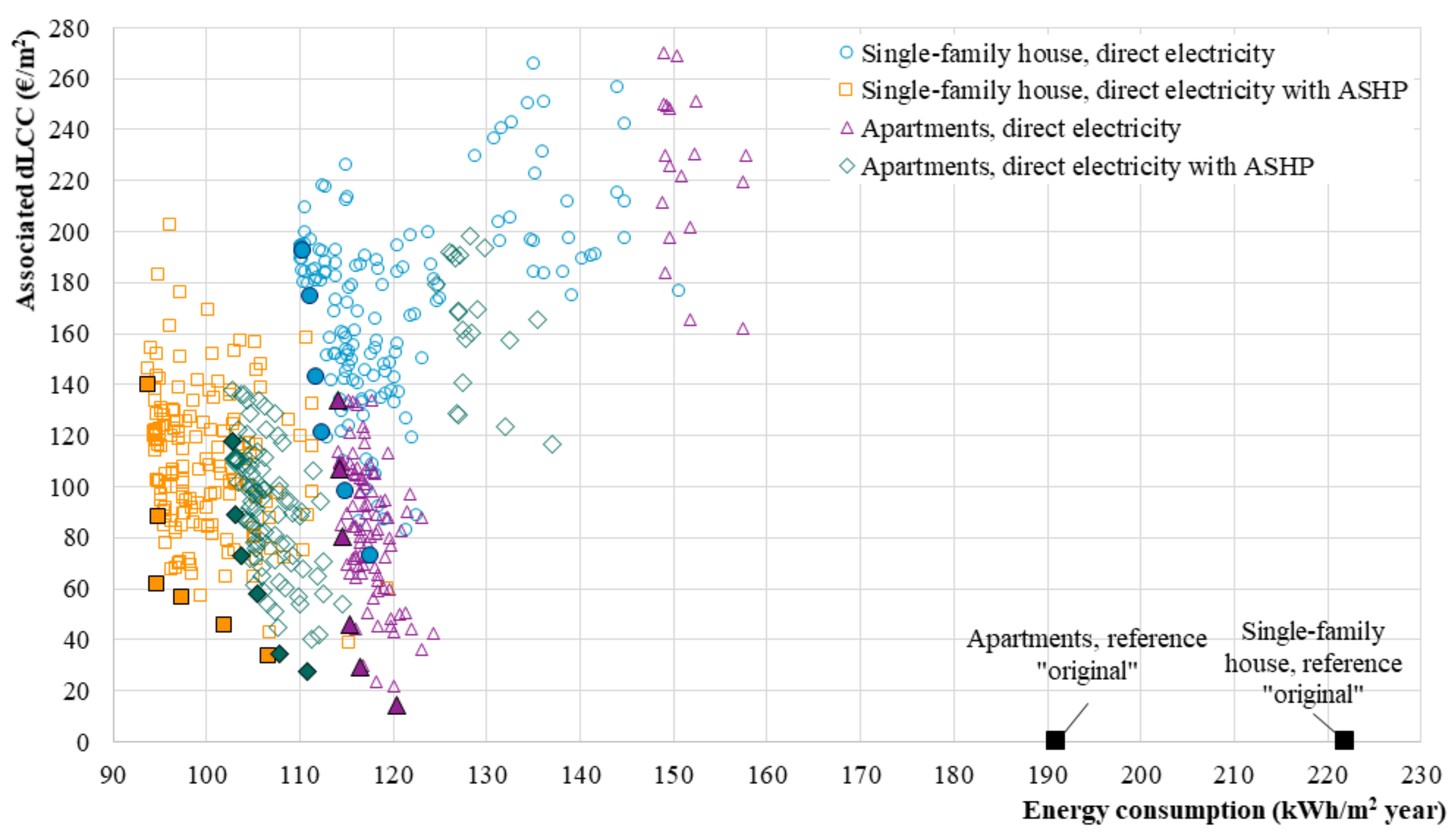
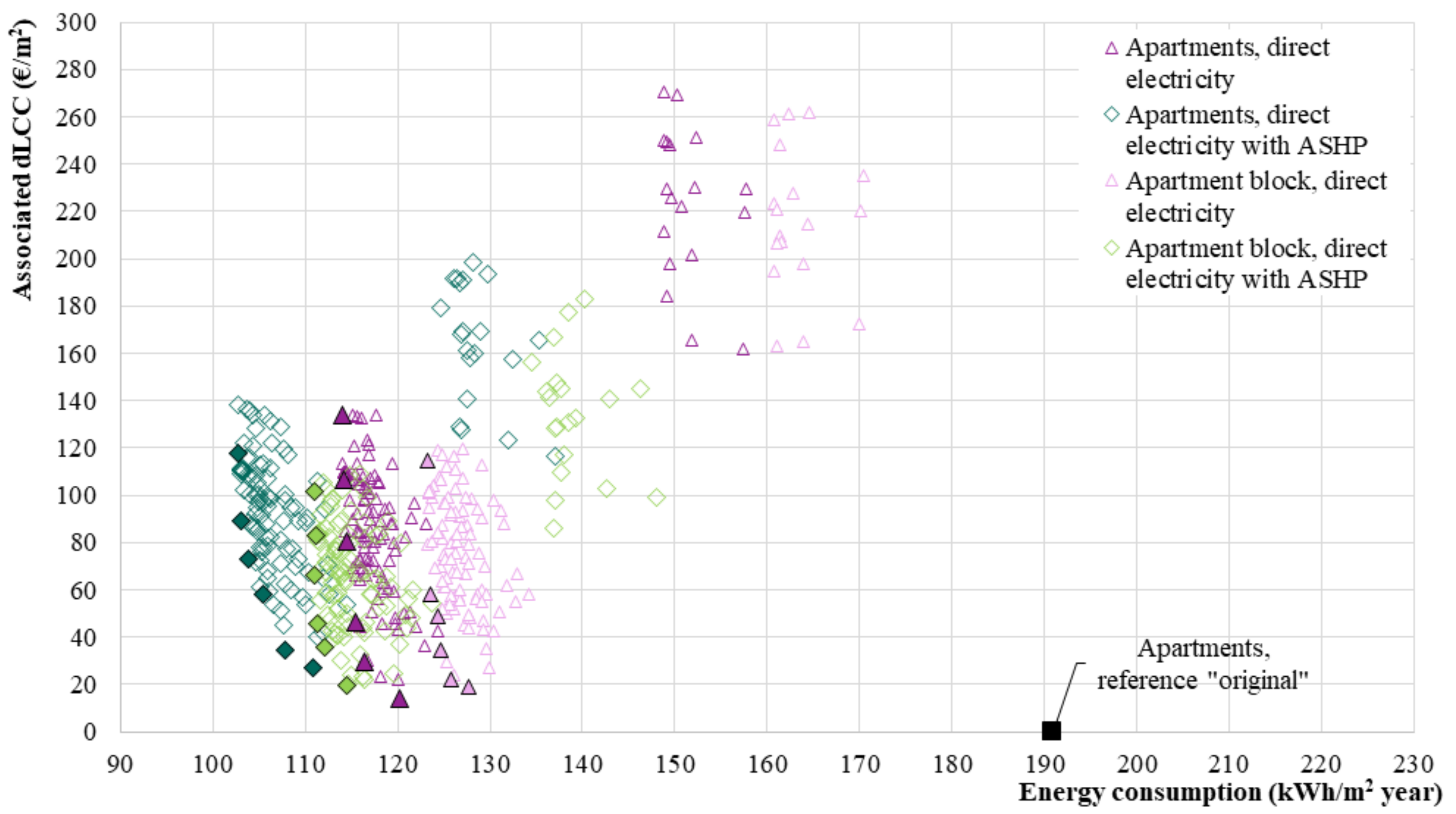
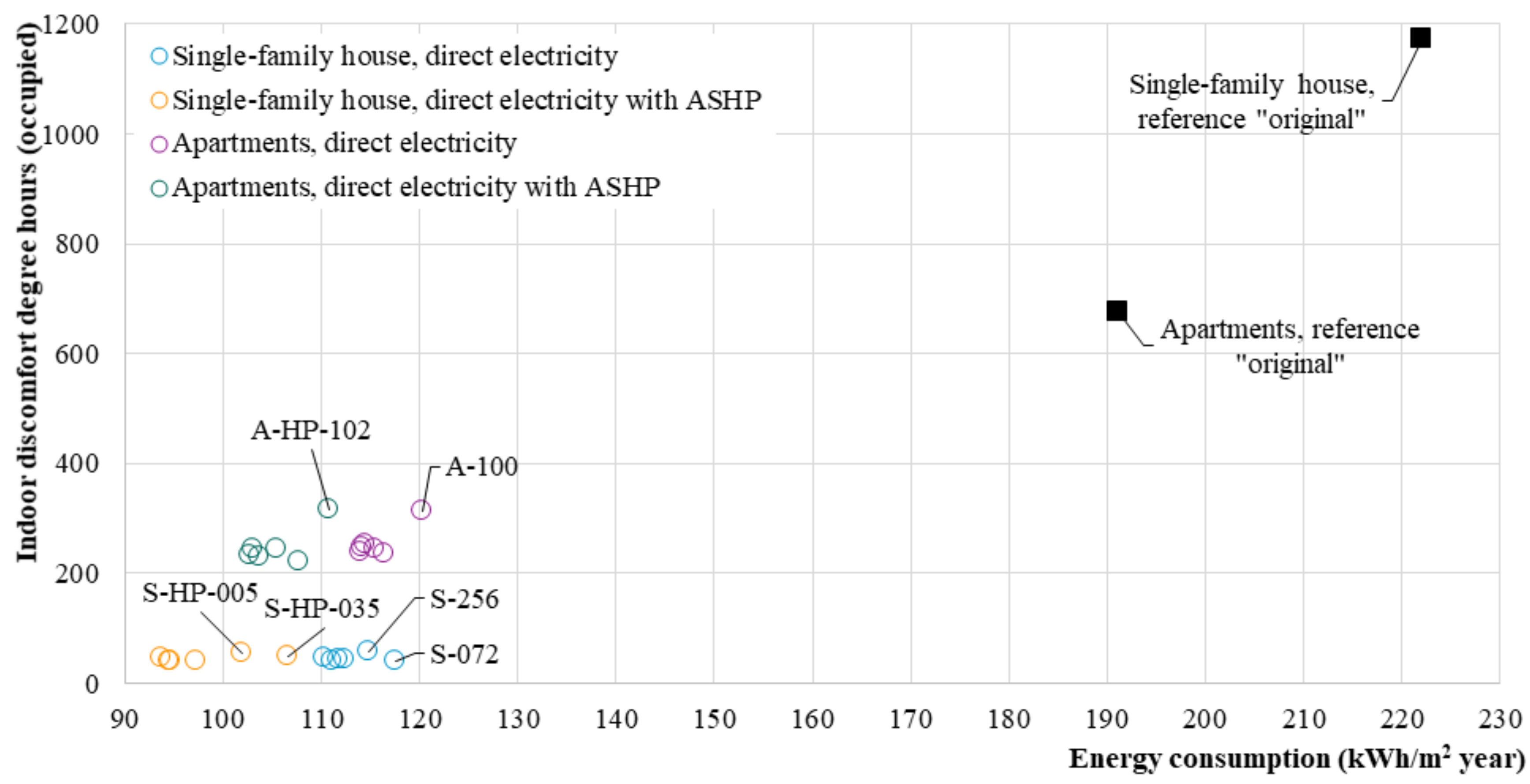
| Parameter | Reference “Original”: Reference Models Built between 1969 and 1985 before Retrofitting | Reference “TEK 17”: Reference Models according to the Minimum Energy Performance Requirements 1 in TEK 17 [20] |
|---|---|---|
| U-value external wall (W/(m2K)) | 0.38 2 | 0.22 |
| U-value roof (W/(m2K)) | 0.20 2 | 0.18 |
| U-value basement wall (W/(m2K)) | 0.81 3 | 0.22 |
| U-value basement floor (W/(m2K)) | 0.36 2 | 0.18 |
| U-value windows (W/(m2K)) | 2.8 4 | 1.2 |
| Infiltration rate (h−1) | 4.0 4 | 1.5 |
| Normalized thermal bridge value (W/(m2K)) | 0.07/0.13 4 | − |
| Specific fan power (kW/(m3s)) | 2.0 4 | − |
| Class | Heating Control | Ventilation Control | Lighting Control | Blind Control |
|---|---|---|---|---|
| D | Proportional–integral (PI) control with a constant temperature setpoint (22 °C) | Constant air volume (CAV) with a constant supply air temperature setpoint (18 °C) | Manual on/off lighting control | Manual control |
| C | Proportional–integral (PI) control with a variable temperature setpoint depending on room function with night setback (variable) | Variable air volume (VAV) with day/nighttime schedule and a constant supply air temperature setpoint (18 °C) | As level D | As level D |
| B | Proportional–integral (PI) control with occupancy detection and a variable temperature setpoint depending on room function with night setback (variable) and extreme setback (16 °C) when the house is not occupied | Variable air volume (VAV) with a day/nighttime schedule and a variable supply air temperature setpoint (16–18 °C) | Automatic on/off control with a day/night schedule, sweeping extinction signal (23:00–06:00) and automatic off-switch when enough daylight (>200 lux) is present | Automatic control based on incoming solar radiation (active when >200 W/m2) |
| A | Proportional–integral (PI) control with demand detection and a variable temperature setpoint depending on room function with night setback (variable) and extreme setback (16 °C) when the zone is not occupied | Variable air volume (VAV) based on demand and with a variable supply air temperature setpoint (16–18 °C) with setback for when the house is not occupied (14–16 °C) | Automatic control with dimming following a day/night schedule, sweeping extinction signal = (23:00–06:00) and automatic off-switch when enough daylight (>200 lux) is present and/or when the room is not occupied | As level B |
| Design Variable | Single-Family House | Apartment Block | |||||
|---|---|---|---|---|---|---|---|
| Options Range | Step Size | Nr. of Steps | Options Range | Step Size | Nr. of Steps | ||
| Building Envelope options | Insulation thickness external walls (m) | 0.2…0.4 | 0.05 | 5 | 0.2…0.4 | 0.05 | 5 |
| Insulation thickness roof (m) | 0.25…0.4 | 0.05 | 4 | 0.2…0.4 | 0.05 | 5 | |
| Insulation thickness basement walls (m) | 0.15…0.3 | 0.05 | 4 | − | − | − | |
| Insulation thickness basement floor (m) | 0.1…0.35 | 0.05 | 6 | − | − | − | |
| Infiltration rate (h−1) | 0.6…1.5 | − 1 | − 1 | 0.6…1.5 | − 1 | − 1 | |
| Normalized thermal bridge value (W/(m2K)) | 0.03…0.05 | − 1 | − 1 | 0.05…0.07 | − 1 | − 1 | |
| - | Options | Nr. of options | Options | Nr. of options | |||
| Windows (t = 0.7, g = 0.5) | U = 1.2 W/(m2K) U = 0.8 W/(m2K) | 2 | U = 1.2 W/(m2K) U = 0.8 W/(m2K) | 2 | |||
| Automation levels | Heating control | Level D Level C Level B Level A | 4 | Level D Level C Level B Level A | 4 | ||
| Ventilation control | Level D Level C Level B Level A | 4 | Level D Level C Level B Level A | 4 | |||
| Lighting control | Level D (and C) Level B Level A | 3 | Level D (and C) Level B Level A | 3 | |||
| Solar shading control | Level D (and C) Level B (and A) | 2 | Level D (and C) Level B (and A) | 2 | |||
| Total possible combinations | 115,200 | 4800 | |||||
| Parameter | TEK 17 Minimum Energy Performance Requirements [20] | TEK 17 Energy-Saving Requirements [20] | Norwegian Passive House Criteria [31] |
|---|---|---|---|
| U-value external wall (W/(m2K)) | ≤0.22 | ≤0.18 | 0.10–0.12 1 |
| U-value roof (W/(m2K)) | ≤0.18 | ≤0.13 | 0.08−0.09 1 |
| U-value basement wall (W/(m2K)) | ≤0.22 | ≤0.18 | 0.10−0.12 1 |
| U-value basement floor (W/(m2K)) | ≤0.18 | ≤0.10 | 0.08 1 |
| U-value windows (W/(m2K)) | ≤1.2 | ≤0.8 | ≤0.8 |
| Infiltration rate (h−1) | ≤1.5 | ≤0.6 | ≤0.6 |
| Normalized thermal bridge value (W/(m2K)) | − | ≤0.05/0.07 | 0.03 |
| Specific fan power (kW/(m3s)) | − | ≤1.5 | ≤1.5 |
| Ventilation heat recovery (%) | − | ≥ 80 | ≥ 80 |
| Room | Lower Limit (PPD = 20%) | Upper Limit (PPD = 20%) |
|---|---|---|
| Bedrooms | ||
| Bathrooms, living rooms and other rooms |
| Energy | - | NS 3031 | Typical | NS 3031 Reference Values | Typical Reference Values 1 | Statistical Reference Values 2 |
|---|---|---|---|---|---|---|
| Space heating (kWh/m2 year) | SF | 118.0 | 160.4 | - | - | - |
| AP | 76.9 | 129.8 | ||||
| HVAC aux (kWh/m2 year) | SF | 7.6 | 7.6 | - | - | - |
| AP | 7.1 | 7.1 | ||||
| Lighting (kWh/m2 year) | SF | 11.4 | 11.9 | 11.4 [18] | - | - |
| AP | 11.5 | 11.7 | ||||
| Equipment (kWh/m2 year) | SF | 17.4 | 17.7 | 17.5 [18] | - | - |
| AP | 17.5 | 17.6 | ||||
| Total energy consumption (kWh/m2 year) | SF | 179.0 | 222.1 | - | 225 | 196.8 |
| AP | 137.9 | 191.1 | - | 165–190 | 153.9 |
| Direct Electricity | Single-Family House | Representative Apartments | ||||||
|---|---|---|---|---|---|---|---|---|
| Space Heating | AHU Heating and Fans | Lighting | Total | Space Heating | AHU Heating and Fans | Lighting | Total | |
| Model D (kWh/m2) | 84.4 | 10.7 | 11.4 | 148.6 | 79.0 | 15.0 | 11.4 | 147.8 |
| Energy consumption compared to model D | ||||||||
| Heating, level C | 78% | 106% | 100% | 88% | 62% | 105% | 100% | 80% |
| Heating, level B | 76% | 109% | 100% | 87% | 62% | 107% | 100% | 81% |
| Heating, level A | 72% | 123% | 100% | 86% | 61% | 109% | 100% | 80% |
| Ventilation, level C | 100% | 86% | 100% | 99% | 102% | 85% | 100% | 100% |
| Ventilation, level B | 105% | 74% | 100% | 101% | 110% | 66% | 100% | 102% |
| Ventilation, level A | 106% | 65% | 100% | 101% | 110% | 66% | 100% | 102% |
| Lighting, level B | 102% | 100% | 65% | 98% | 100% | 100% | 65% | 97% |
| Lighting, level A | 105% | 101% | 39% | 98% | 102% | 101% | 45% | 97% |
| Blinds, level A | 101% | 100% | 100% | 100% | 99% | 100% | 100% | 100% |
| Complete level C | 79% | 91% | 100% | 87% | 62% | 90% | 100% | 79% |
| Complete level B | 86% | 77% | 64% | 86% | 69% | 70% | 61% | 78% |
| Complete level A | 86% | 72% | 39% | 84% | 70% | 71% | 40% | 76% |
| Direct Electricity with an Air Source Heat Pump | Single-Family House | Representative Apartments | ||||||
|---|---|---|---|---|---|---|---|---|
| Space Heating | AHU Heating and Fans | Lighting | Total | Space Heating | AHU Heating and Fans | Lighting | Total | |
| Model D (kWh/m2) | 48.7 | 14.1 | 11.4 | 116.3 | 52.9 | 17.2 | 11.4 | 123.9 |
| Energy consumption compared to model D | ||||||||
| Heating, level C | 79% | 99% | 100% | 91% | 60% | 102% | 100% | 83% |
| Heating, level B | 80% | 100% | 100% | 92% | 63% | 103% | 100% | 85% |
| Heating, level A | 74% | 109% | 100% | 90% | 62% | 104% | 100% | 84% |
| Ventilation, level C | 99% | 89% | 100% | 98% | 101% | 87% | 100% | 99% |
| Ventilation, level B | 106% | 82% | 100% | 100% | 107% | 71% | 100% | 99% |
| Ventilation, level A | 104% | 78% | 100% | 99% | 108% | 71% | 100% | 99% |
| Lighting, level B | 101% | 101% | 65% | 97% | 98% | 100% | 65% | 96% |
| Lighting, level A | 105% | 102% | 39% | 96% | 101% | 101% | 45% | 95% |
| Blinds, level A | 100% | 100% | 100% | 100% | 99% | 100% | 100% | 100% |
| Complete level C | 79% | 88% | 100% | 90% | 60% | 88% | 100% | 81% |
| Complete level B | 87% | 78% | 64% | 88% | 70% | 71% | 61% | 79% |
| Complete level A | 85% | 77% | 39% | 85% | 72% | 72% | 40% | 79% |
| Name | Energy (kWh/m2 Year) | dLCC (€/m2) | Insulation Thickness (m) | U-Value Glazing (W/m2K) | Control Strategies Class | ||||||
|---|---|---|---|---|---|---|---|---|---|---|---|
| External Wall | Roof | Basement Wall | Floor | Heating | Ventilation | Lighting | Blinds | ||||
| S-005 | 117.5 | 73.1 | 0.35 | 0.3 | 0.15 | 0.2 | 0.8 | A | B | D | D |
| S-256 | 114.9 | 98.4 | 0.4 | 0.35 | 0.2 | 0.2 | 0.8 | A | B | B | D |
| S-258 | 112.4 | 121.4 | 0.4 | 0.4 | 0.2 | 0.3 | 0.8 | A | B | A | D |
| S-226 | 111.7 | 143.1 | 0.4 | 0.4 | 0.2 | 0.3 | 0.8 | A | D | A | D |
| S-296 | 111.1 | 174.8 | 0.4 | 0.4 | 0.2 | 0.2 | 0.8 | A | C | A | D |
| S-307 | 110.4 | 192.8 | 0.4 | 0.4 | 0.3 | 0.35 | 0.8 | A | C | A | D |
| Name | Energy (kWh/m2 Year) | dLCC (€/m2) | Insulation Thickness (m) | U-Value Glazing (W/m2K) | Control Strategies Class | ||||||
|---|---|---|---|---|---|---|---|---|---|---|---|
| External Wall | Roof | Basement Wall | Floor | Heating | Ventilation | Lighting | Blinds | ||||
| S-HP-035 | 106.6 | 33.6 | 0.25 | 0.4 | 0.2 | 0.25 | 1.2 | B | D | D | D |
| S-HP-005 | 101.9 | 45.9 | 0.3 | 0.3 | 0.25 | 0.15 | 0.8 | A | B | D | D |
| S-HP-190 | 97.3 | 57.1 | 0.35 | 0.35 | 0.25 | 0.25 | 0.8 | A | B | B | D |
| S-HP-262 | 94.7 | 88.6 | 0.35 | 0.4 | 0.25 | 0.25 | 0.8 | A | A | A | D |
| S-HP-257 | 94.6 | 62.1 | 0.4 | 0.4 | 0.2 | 0.3 | 0.8 | A | B | A | D |
| S-HP-164 | 93.8 | 140.4 | 0.4 | 0.4 | 0.2 | 0.3 | 0.8 | A | C | A | D |
| Name | Energy (kWh/m2 Year) | dLCC (€/m2) | Insulation Thickness (m) | U-Value Glazing (W/m2K) | Control Strategies Class | ||||
|---|---|---|---|---|---|---|---|---|---|
| External Wall | Roof | Heating | Ventilation | Lighting | Blinds | ||||
| A-100 | 120.3 | 14.1 | 0.4 | 0.3 | 1.2 | B | C | D | D |
| A-235 | 116.4 | 29.4 | 0.4 | 0.4 | 1.2 | C | B | B | D |
| A-042 | 115.4 | 46.1 | 0.35 | 0.4 | 1.2 | C | C | B | B |
| A-046 | 114.5 | 80.7 | 0.4 | 0.4 | 0.8 | A | C | A | D |
| A-160 | 114.2 | 106.6 | 0.4 | 0.4 | 0.8 | A | A | B | B |
| A-105 | 114.1 | 133.9 | 0.4 | 0.4 | 0.8 | A | A | A | B |
| Name | Energy (kWh/m2 Year) | dLCC (€/m2) | Insulation Thickness (m) | U-Value Glazing (W/m2K) | Control Strategies Class | ||||
|---|---|---|---|---|---|---|---|---|---|
| External Wall | Roof | Heating | Ventilation | Lighting | Blinds | ||||
| A-HP-102 | 110.8 | 27.3 | 0.4 | 0.3 | 1.2 | B | C | D | D |
| A-HP-231 | 107.8 | 34.6 | 0.4 | 0.3 | 1.2 | C | B | B | D |
| A-HP-042 | 105.5 | 57.9 | 0.35 | 0.4 | 1.2 | C | C | B | B |
| A-HP-066 | 103.8 | 73.2 | 0.4 | 0.4 | 1.2 | A | B | A | D |
| A-HP-227 | 103.1 | 89.0 | 0.4 | 0.4 | 1.2 | A | A | A | D |
| A-HP-014 | 102.8 | 117.7 | 0.4 | 0.4 | 1.2 | A | A | A | B |
Publisher’s Note: MDPI stays neutral with regard to jurisdictional claims in published maps and institutional affiliations. |
© 2020 by the authors. Licensee MDPI, Basel, Switzerland. This article is an open access article distributed under the terms and conditions of the Creative Commons Attribution (CC BY) license (http://creativecommons.org/licenses/by/4.0/).
Share and Cite
Felius, L.C.; Hamdy, M.; Dessen, F.; Hrynyszyn, B.D. Upgrading the Smartness of Retrofitting Packages towards Energy-Efficient Residential Buildings in Cold Climate Countries: Two Case Studies. Buildings 2020, 10, 200. https://doi.org/10.3390/buildings10110200
Felius LC, Hamdy M, Dessen F, Hrynyszyn BD. Upgrading the Smartness of Retrofitting Packages towards Energy-Efficient Residential Buildings in Cold Climate Countries: Two Case Studies. Buildings. 2020; 10(11):200. https://doi.org/10.3390/buildings10110200
Chicago/Turabian StyleFelius, Laurina C., Mohamed Hamdy, Fredrik Dessen, and Bozena Dorota Hrynyszyn. 2020. "Upgrading the Smartness of Retrofitting Packages towards Energy-Efficient Residential Buildings in Cold Climate Countries: Two Case Studies" Buildings 10, no. 11: 200. https://doi.org/10.3390/buildings10110200
APA StyleFelius, L. C., Hamdy, M., Dessen, F., & Hrynyszyn, B. D. (2020). Upgrading the Smartness of Retrofitting Packages towards Energy-Efficient Residential Buildings in Cold Climate Countries: Two Case Studies. Buildings, 10(11), 200. https://doi.org/10.3390/buildings10110200






